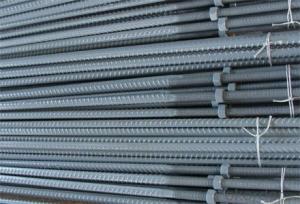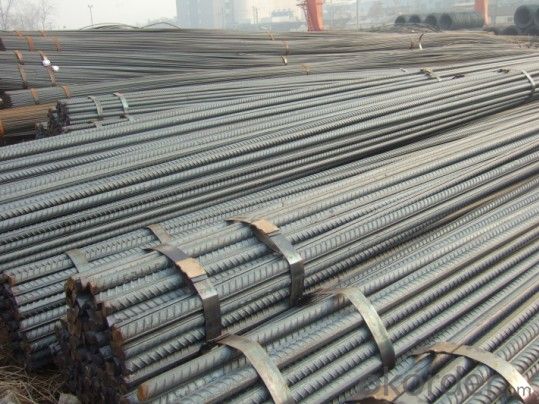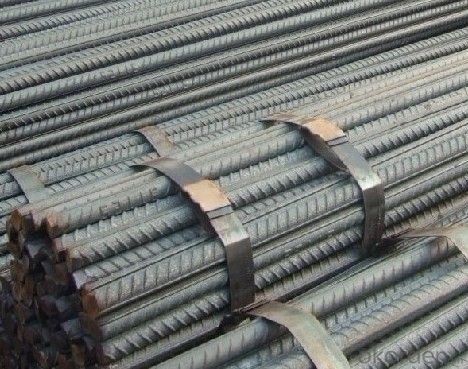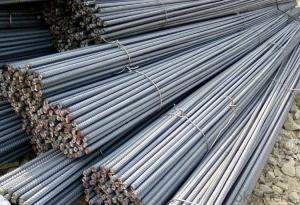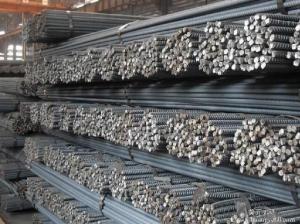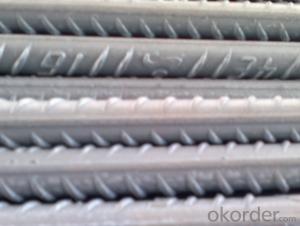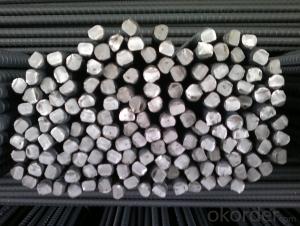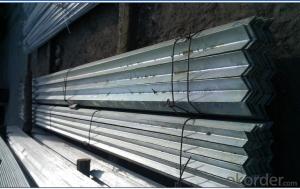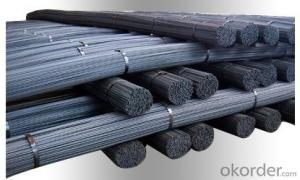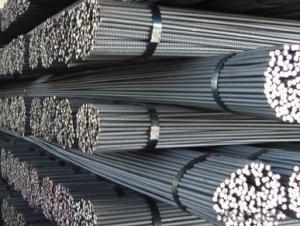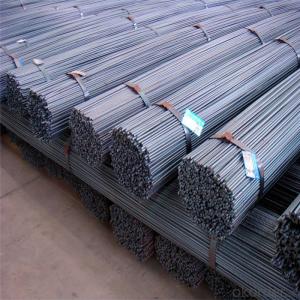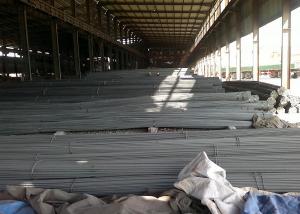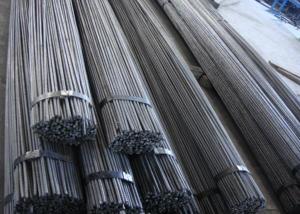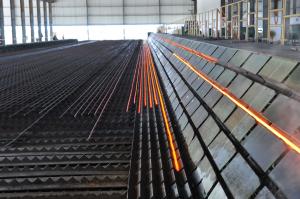GR40 deformed steel bar bar for construction
- Loading Port:
- Tianjin
- Payment Terms:
- TT OR LC
- Min Order Qty:
- 10000 m.t.
- Supply Capability:
- 100000 m.t./month
OKorder Service Pledge
OKorder Financial Service
You Might Also Like
Specification
OKorder is offering high quality GR40 deformed steel bar bar for construction at great prices with worldwide shipping. Our supplier is a world-class manufacturer of steel, with our products utilized the world over. OKorder annually supplies products to European, North American and Asian markets. We provide quotations within 24 hours of receiving an inquiry and guarantee competitive prices.
Product Applications:
GR40 deformed steel bar bar for construction for construction for construction are ideal for structural applications and are widely used in the construction of buildings and bridges, and the manufacturing, petrochemical, and transportation industries.
Product Advantages:
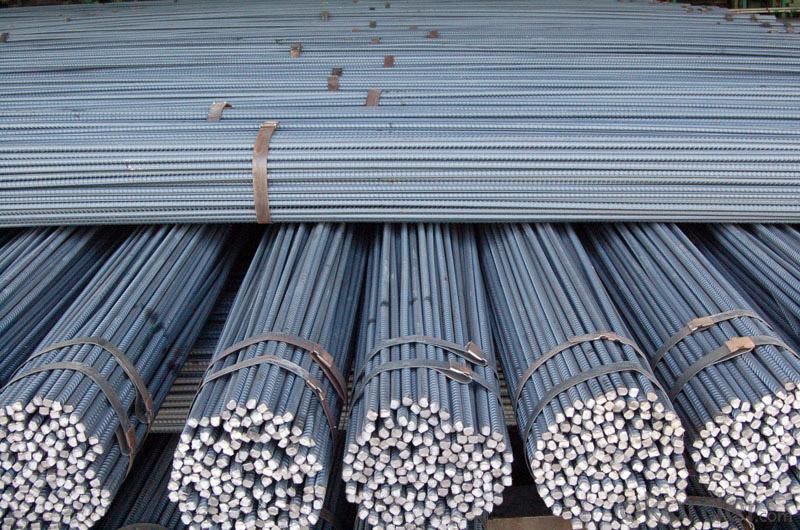

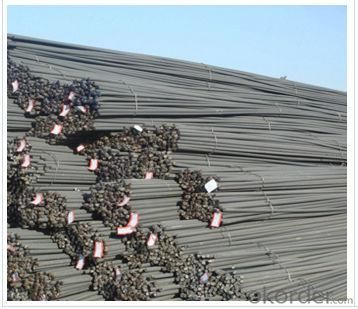
OKorder's deformed steel bar are durable, strong, and resist corrosion.
Main Product Features:
· Premium quality
· Prompt delivery & seaworthy packing (30 days after receiving deposit)
· Corrosion resistance
· Can be recycled and reused
· Mill test certification
· Professional Service
· Competitive pricing
Product Specifications:
Standard | GB | HRB400 | |
Diameter | 6mm,8mm,10mm,12mm,14mm,16mm,18mm,20mm, 22mm,25mm,28mm,32mm,36mm,40mm,50mm | ||
Length | 6M, 9M,12M or as required | ||
Place of origin | Hebei, China mainland | ||
Advantages | exact size, regular package, chemical and mechanical properties are stable. | ||
Type | Hot rolled deformed steel bar | ||
Brand name | DRAGON | ||
Chemical Composition: (Please kindly find our chemistry of our material based on HRB500 as below for your information)
Grade | Technical data of the original chemical composition (%) | ||||||
C | Mn | Si | S | P | V | ||
HRB400 | ≤0.25 | ≤1.60 | ≤0.80 | ≤0.045 | ≤0.045 | 0.04-0.12 | |
Physical capability | |||||||
Yield Strength (N/cm²) | Tensile Strength (N/cm²) | Elongation (%) | |||||
≥400 | ≥570 | ≥14 | |||||
Theoretical weight and section area of each diameter as below for your information:
Diameter(mm) | Section area (mm²) | Mass(kg/m) | Weight of 12m bar(kg) |
6 | 28.27 | 0.222 | 2.664 |
8 | 50.27 | 0.395 | 4.74 |
10 | 78.54 | 0.617 | 7.404 |
12 | 113.1 | 0.888 | 10.656 |
14 | 153.9 | 1.21 | 14.52 |
16 | 201.1 | 1.58 | 18.96 |
18 | 254.5 | 2.00 | 24 |
20 | 314.2 | 2.47 | 29.64 |
22 | 380.1 | 2.98 | 35.76 |
25 | 490.9 | 3.85 | 46.2 |
28 | 615.8 | 4.83 | 57.96 |
32 | 804.2 | 6.31 | 75.72 |
36 | 1018 | 7.99 | 98.88 |
40 | 1257 | 9.87 | 118.44 |
50 | 1964 | 15.42 | 185.04 |
Deformed bar is widely used in buildings, bridges, roads and other engineering construction. Big to highways, railways, bridges, culverts, tunnels, public facilities such as flood control, dam, small to housing construction, beam, column, wall and the foundation of the plate, deformed bar is an integral structure material. With the development of world economy and the vigorous development of infrastructure construction, real estate, the demand for deformed bar will be larger and larger..
Packaging & Delivery of HR Deformed Steel Rebars of Good Quality: Packaging Detail: products are packed in bundle and then shipped by container or bulk vessel, deformed bar is usually naked strapping delivery, when storing, please pay attention to moisture proof. The performance of rust will produce adverse effect. Each bundle weight: 2-3MT, or as required Payment terms: TT payment in advance or Irrevocable LC at sight. Trade terms :FOB, CFR, CIF Delivery Detail: within 45 days after received advanced payment or LC. FAQ: Q1: What makes stainless steel stainless? A1: Stainless steel must contain at least 10.5 % chromium. It is this element that reacts with the oxygen in the air to form a complex chrome-oxide surface layer that is invisible but strong enough to prevent further oxygen from "staining" (rusting) the surface. Higher levels of chromium and the addition of other alloying elements such as nickel and molybdenum enhance this surface layer and improve the corrosion resistance of the stainless material. Q2: Can stainless steel rust? A2: Stainless does not "rust" as you think of regular steel rusting with a red oxide on the surface that flakes off. If you see red rust it is probably due to some iron particles that have contaminated the surface of the stainless steel and it is these iron particles that are rusting. Look at the source of the rusting and see if you can remove it from the surface. |
- Q: What are the safety precautions while handling steel rebars?
- Some safety precautions while handling steel rebars include wearing appropriate personal protective equipment such as gloves, safety glasses, and steel-toe boots to protect against cuts, punctures, and potential falling objects. It is important to handle rebars with caution, avoiding any sudden movements or swinging motions that could cause injury. Additionally, workers should be trained on proper lifting techniques to prevent strains and sprains. Ensuring a clean and organized work area, and keeping rebars stacked securely to prevent them from toppling over, are also crucial safety measures.
- Q: How are steel rebars used in the construction of power transmission towers?
- Steel rebars are commonly used in the construction of power transmission towers to provide reinforcement and strength to the structure. These rebars are typically made of high-strength steel and are used in various components of the tower, such as the foundation, columns, and cross arms. In the foundation, steel rebars are embedded in concrete to increase its load-bearing capacity. The rebars help distribute the weight of the tower and the transmission lines, ensuring that the foundation remains stable and can withstand the forces exerted on it. Within the tower columns, steel rebars are used to reinforce the concrete structure, enhancing its overall strength and stability. This is crucial as power transmission towers are often exposed to strong winds, seismic activities, and other external forces. The rebars prevent the concrete from cracking or collapsing under these conditions, ensuring the tower's integrity and longevity. Steel rebars are also employed in the construction of cross arms, which are the horizontal members that support the transmission lines. These rebars provide additional reinforcement to the cross arms, enabling them to carry the weight of the lines effectively. This is especially important as power transmission lines can span over long distances and carry heavy loads. Overall, steel rebars play a vital role in the construction of power transmission towers by providing the necessary strength and reinforcement to ensure the tower's stability and durability. Without these rebars, the towers would be more susceptible to structural failures and pose a risk to the transmission lines and surrounding areas.
- Q: What are the guidelines for proper placement of steel rebars in concrete structures?
- To ensure the structural integrity and durability of concrete structures, it is crucial to place steel rebars correctly. Here are some guidelines to follow for proper rebar placement: 1. Consider the Design: Begin by referring to the structural drawings and specifications provided by the engineer. These documents will outline the required rebar sizes, spacing, and any specific details or arrangements needed for the project. 2. Determine Rebar Size and Spacing: The size and spacing of rebars should be based on the structural requirements and load-bearing capacity of the concrete structure. Adhere to the design specifications for the diameter and spacing of rebars to provide sufficient reinforcement. 3. Maintain Concrete Cover: The distance between the outer surface of the rebar and the edge of the concrete is called the concrete cover. This cover protects the rebars from corrosion and provides fire resistance. It is essential to maintain the specified concrete cover to ensure the rebars' longevity. 4. Consider Lap Length: When rebars need to be spliced or joined together, a lap length is specified. This length ensures enough overlap for stress transfer between rebars and prevents weak points in the structure. 5. Align and Position Rebars: Properly align and position rebars within the concrete formwork. Place them in the center of the concrete section to effectively resist tension and compression forces. Spacers or chairs can be used to maintain the desired rebar position during concrete pouring and setting. 6. Maintain Clearances and Edge Distance: Adequate clearances between rebars must be maintained to allow proper concrete flow during casting. Similarly, minimum edge distances should be maintained to prevent rebar corrosion and ensure proper concrete cover. 7. Tie and Fix Rebars: Securely tie and fix rebars at intersections to prevent displacement during concrete placement. Properly tying rebars using wire or approved connectors helps maintain their position and ensures the concrete's structural integrity. 8. Conduct Inspections and Quality Control: Regular inspections should be carried out during the concrete pouring process to verify correct rebar placement according to the design specifications. Address any deviations or discrepancies promptly to avoid compromising the structure's integrity. By following these guidelines, construction professionals can ensure the correct placement of steel rebars in concrete structures. This will result in safe and durable constructions that can withstand design loads and provide long-term structural stability.
- Q: What are the advantages of using stainless steel rebars?
- Using stainless steel rebars in construction projects offers several advantages. Firstly, these rebars have a remarkable resistance to corrosion, making them perfect for structures in harsh environments such as coastal or industrial areas. Unlike traditional carbon steel rebars, stainless steel rebars do not easily rust or corrode, ensuring the durability and longevity of the structure. Secondly, stainless steel rebars possess a higher tensile strength compared to carbon steel rebars. This means they can endure greater stress and loads without deforming or breaking, resulting in a safer and more reliable structure. Moreover, their high tensile strength allows for the utilization of smaller rebars, which saves construction costs and reduces the overall weight of the structure. Furthermore, stainless steel rebars exhibit excellent fire resistance properties. They retain their strength and integrity much better than carbon steel in the event of a fire, reducing the risk of structural collapse. This is particularly crucial in buildings with high fire safety requirements, such as hospitals, schools, and high-rise structures. Another advantage of stainless steel rebars is their low maintenance requirements. Due to their corrosion resistance, they do not need regular inspections or costly protective coatings. This saves both time and money in maintenance efforts. Lastly, stainless steel rebars are highly sustainable and environmentally friendly. They are 100% recyclable, reducing the demand for new raw materials and minimizing waste in construction projects. Additionally, the long lifespan of stainless steel rebars reduces the need for frequent replacements, further minimizing the environmental impact. To summarize, the benefits of using stainless steel rebars include excellent corrosion resistance, high tensile strength, superior fire resistance, low maintenance requirements, and sustainability. These advantages make stainless steel rebars the preferred choice for construction projects that prioritize durability, safety, and long-term value.
- Q: Can steel rebars be used in parking structure construction?
- Using steel rebars in parking structure construction is a common practice. They provide strength and durability to reinforced concrete structures. The use of steel rebars is especially important in parking structures due to the heavy loads and traffic they experience. These rebars are typically placed in the concrete slabs, walls, and columns of the structure, improving its load-bearing capacity and resistance to compression, tension, and bending. Additionally, steel rebars can also reinforce ramps, driveways, and other areas that require extra support. Overall, incorporating steel rebars is crucial in parking structure construction to comply with safety standards and ensure the facility's longevity.
- Q: How are steel rebars labeled or marked for identification?
- Steel rebars are typically labeled or marked for identification through the use of specific symbols, numbers, or letters. This identification system allows for easy recognition of the rebar's characteristics, such as its size, grade, and manufacturer. These markings can be found on the surface of the rebar, providing crucial information to ensure proper usage and structural integrity in construction projects.
- Q: What is thread steel for?
- Three rebar is the new standard name for HRB400 steel, three steel for the old, as a kind of hot rolled ribbed bar. In construction, three - grade rebar is called the past.
- Q: How do steel rebars affect the overall creep and shrinkage of concrete structures?
- Steel rebars have a significant influence on the overall creep and shrinkage of concrete structures. The presence of rebars helps to control and minimize the shrinkage of concrete by providing restraint and reducing the amount of drying shrinkage. Additionally, rebars contribute to the overall stiffness of the structure, decreasing the potential for creep deformation over time. Therefore, steel rebars play a crucial role in mitigating both creep and shrinkage in concrete structures, ensuring their stability and durability.
- Q: What is the minimum lap length required for steel rebars in concrete?
- The minimum lap length required for steel rebars in concrete is typically determined by local building codes and design specifications. These requirements may vary depending on factors such as the diameter of the rebar, the type of concrete being used, and the intended structural application. It is important to consult the relevant codes and design guidelines to determine the specific minimum lap length for a given project.
- Q: How do steel rebars contribute to the strength of a structure?
- Steel rebars contribute to the strength of a structure by providing reinforcement and enhancing its load-bearing capacity. They are embedded within concrete to resist tensile forces, which concrete alone cannot withstand. The combination of steel rebars and concrete creates a composite material that can resist bending, cracking, and structural failure, thereby increasing the overall strength and durability of the structure.
Send your message to us
GR40 deformed steel bar bar for construction
- Loading Port:
- Tianjin
- Payment Terms:
- TT OR LC
- Min Order Qty:
- 10000 m.t.
- Supply Capability:
- 100000 m.t./month
OKorder Service Pledge
OKorder Financial Service
Similar products
Hot products
Hot Searches
Related keywords
